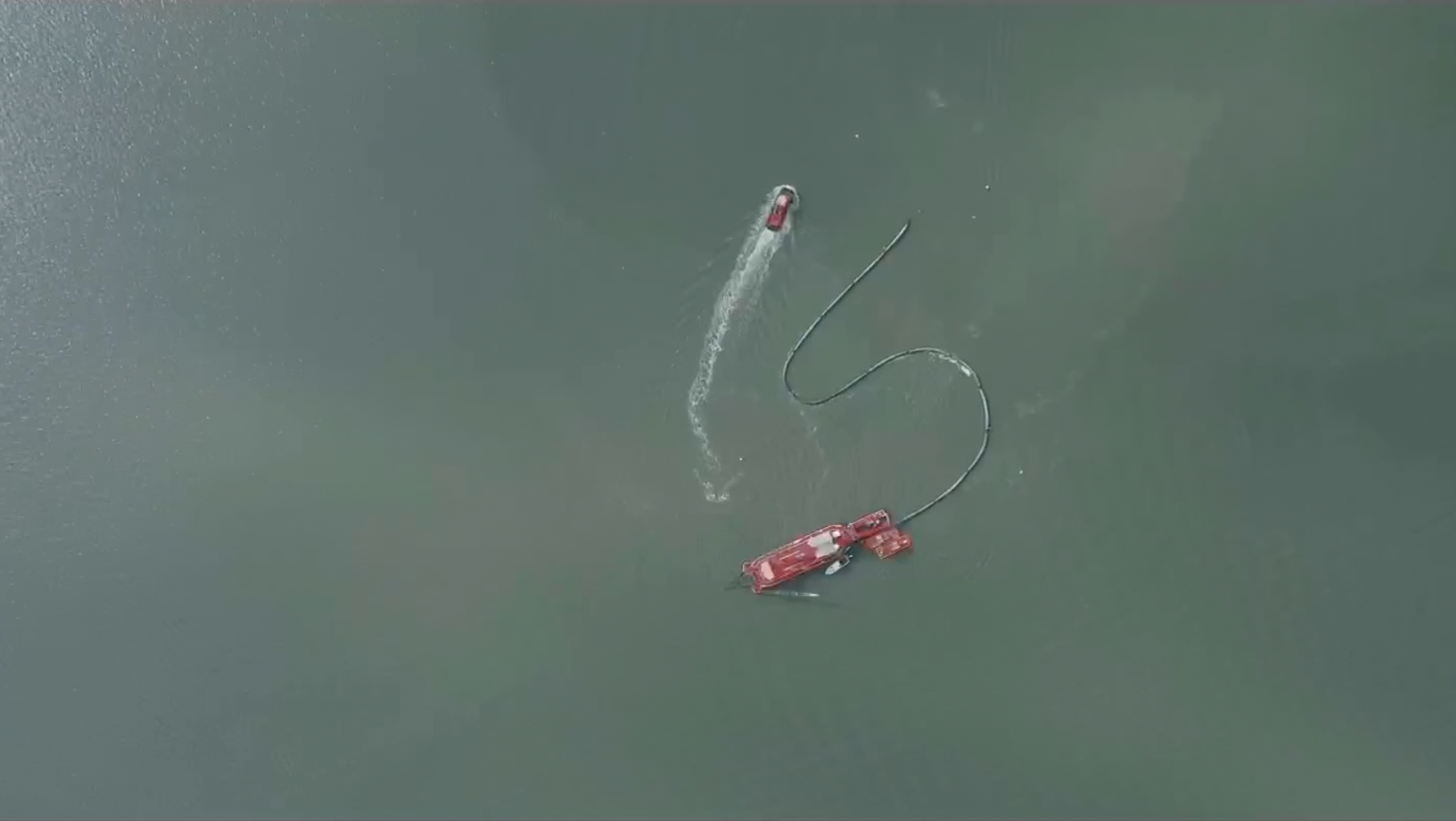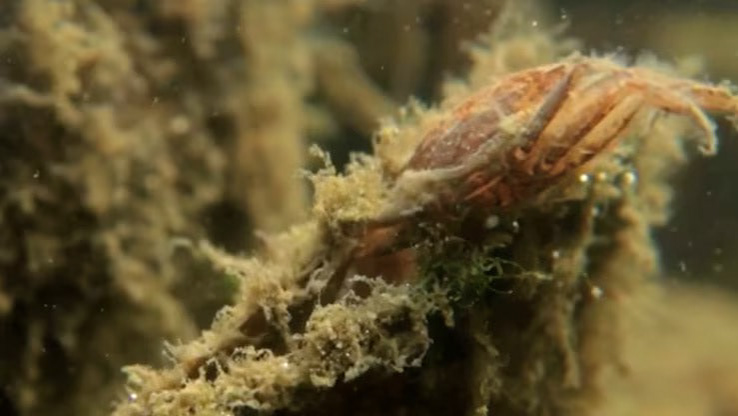VIRGINIA BEACH - An ambitious environmental restoration project is underway in Virginia Beach, Virginia which works towards a brighter future for the entire Chesapeake Bay area. The U.S. Army Corps of Engineers (USACE) has partnered with the City of Virginia Beach in what is known as the Lynnhaven River Basin Ecosystem Restoration Project in order to decrease what total maximum daily loads (TMDL) of toxins and bacteria in the Chesapeake Bay and surrounding tributaries through wetland restoration, the reintroduction of threatened submerged aquatic vegetation, and the construction of artificial hard oyster reefs.
U.S. Army Corps of Engineers (USACE) biologists and engineers join crew members of USACE vessel Fentress to launch an underwater drone and monitor an oyster reef site in Broad Bay, Virginia Beach, Virginia in June, 2023. Photograph provided by James E Walker IV.
For years, the Lynnhaven River suffered from impairments which rendered its oysters and fish unsafe for human consumption and the overall goal . However, through dedicated efforts and strategic interventions, this vital estuary has begun to see a significant turnaround. This project, initiated with planning in 2005 and presented to the City of Virginia Beach in 2009, aims to enhance the river's health for the benefit of all its users.
USACE Biologist Peyton Mowery said, “this project is still ongoing and the collaboration between USACE, the City of Virginia Beach, environmental groups, and the community pretty much highlights the potential for a paradigm shift in environmental stewardship. With such a comprehensive approach to addressing water quality, habitat restoration, the Lynnhaven River Basin Ecosystem Restoration Project stands as a testament to the power of collective action in our backyards.”
Authorized by a resolution from the Committee on Transportation and Infrastructure of the U.S. House of Representatives in 1998, the project's feasibility was confirmed after extensive studies and public engagement. It aligns with the WRDA Executive Order 13508 for Chesapeake Bay Protection and Restoration and the 2014 Chesapeake Bay Agreement, which highlights the Lynnhaven River as a priority tributary for restoration by 2025.
U.S. Army Corps of Engineers (USACE) biologists conduct a sector-by-sector monitoring of vegetation growth and wildlife diversity at a wetlands ecosystem restoration site in Virginia Beach, Virginia in May, 2022. Photograph provided by James E Walker IV.
U.S. Army Corps of Engineers (USACE) biologists conduct monitoring of wetlands ecosystem restoration site in Virginia Beach, Virginia in May, 2022. Photograph provided by James E Walker IV.
The project's scope is vast and multifaceted, targeting 38 acres of wetlands restoration, 94 acres of submerged aquatic vegetation (SAV) to bolster the ecosystem, and 31 acres of reef habitat to support marine life diversity. These efforts are crucial for improving water quality, providing habitat for fish and other marine species, and bolstering the river's resilience against climate change.
Since the 1960s commercial oyster harvests in the Chesapeake Bay have experienced dramatic declines in population due to overharvest and disease. Decreases in water quality and subsequent diseases have been caused by the infiltration of agriculture toxins and other dangerous bacterial such as fecal coliform into the water with city runoff as the human population and activity increased over time. The health of the oyster population has been measured in the number of harvested bushels historically. In 1960, it was possible to acquire six-million bushels of harvested oyster. Today, boat captains struggle to get a quarter of a million bushels collectively.
Scientists from the Virginia Institute of Marine Science (VIMS) and the U.S. Army Corps of Engineers (USACE) transported viable eelgrass (Zostera marina) and widgeon-grass (Ruppia maritima) seeds to Broad Bay, Virginia Beach for planting on January 30th, 2024. The purpose of this planting is to increase water quality and strengthen the diversity of wildlife in this habitat. Photograph provided by James E Walker IV.
Scientists from the Virginia Institute of Marine Science (VIMS) and the U.S. Army Corps of Engineers (USACE) transported viable eelgrass (Zostera marina) and widgeongrass (Ruppia maritima) seeds to Broad Bay, Virginia Beach for planting on January 30th, 2024. The purpose of this planting is to increase water quality and strengthen the diversity of wildlife in this habitat. Photograph provided by James E Walker IV.
Norman Lyster, the president of the Broad Bay Island Civic League and property owner in Virginia Beach confirms the positive impact oyster population restoration efforts have had in the waterway behind his home. “When my family first moved to this area and purchased this home, it was a beautiful area of course. That’s why we purchased the home but the water was in no way this clear. With time, the water clarity has improved and with time, the number of oysters visible in the water has also increased. Other wildlife has returned and increased in frequency as well. There is an obvious correlation between the restoration efforts and health of waters we recreate in” Norm stated confidently.
The restoration of wetlands plays a pivotal role in the project, focusing on the removal of invasive species to restore these natural filters that trap and clean runoff before it reaches the waterway. Similarly, the introduction of SAV and hard reef habitats aims to enrich the aquatic environment, providing essential conditions for the survival and proliferation of various species.
The Chesapeake Bay, its tributaries and their progress report scores. Image provided by the University of Maryland's Center for Environmental Science.
The tributaries which flow through the Commonwealth of Virginia and the State of Maryland are ultimately connected to the Chesapeake Bay and every human action on and around the water has an impact. According to the project's Final Feasibility Report and Integrated Environmental Assessment, the environmental decline and decrease in water quality of the Lynnhaven River is attributed to local agricultural methods, farming practices, and subsequent increased amounts of sediments. As farms gave way to neighborhoods, this situation has been further compounded overtime by runoff from paved surfaces, leaking septic systems, and inadequate waste management practices which have contributed to high levels of bacteria, such as fecal coliform, into recreational and fishing waters.
Watch this video to see how a multifaceted and synergetic initiative to ensure abundant life and clean water in a single estuary can have compounding positive effects on the health of the overall Chesapeake Bay when communities, local governments and federal organizations work together with a shared vision for a better tomorrow.










